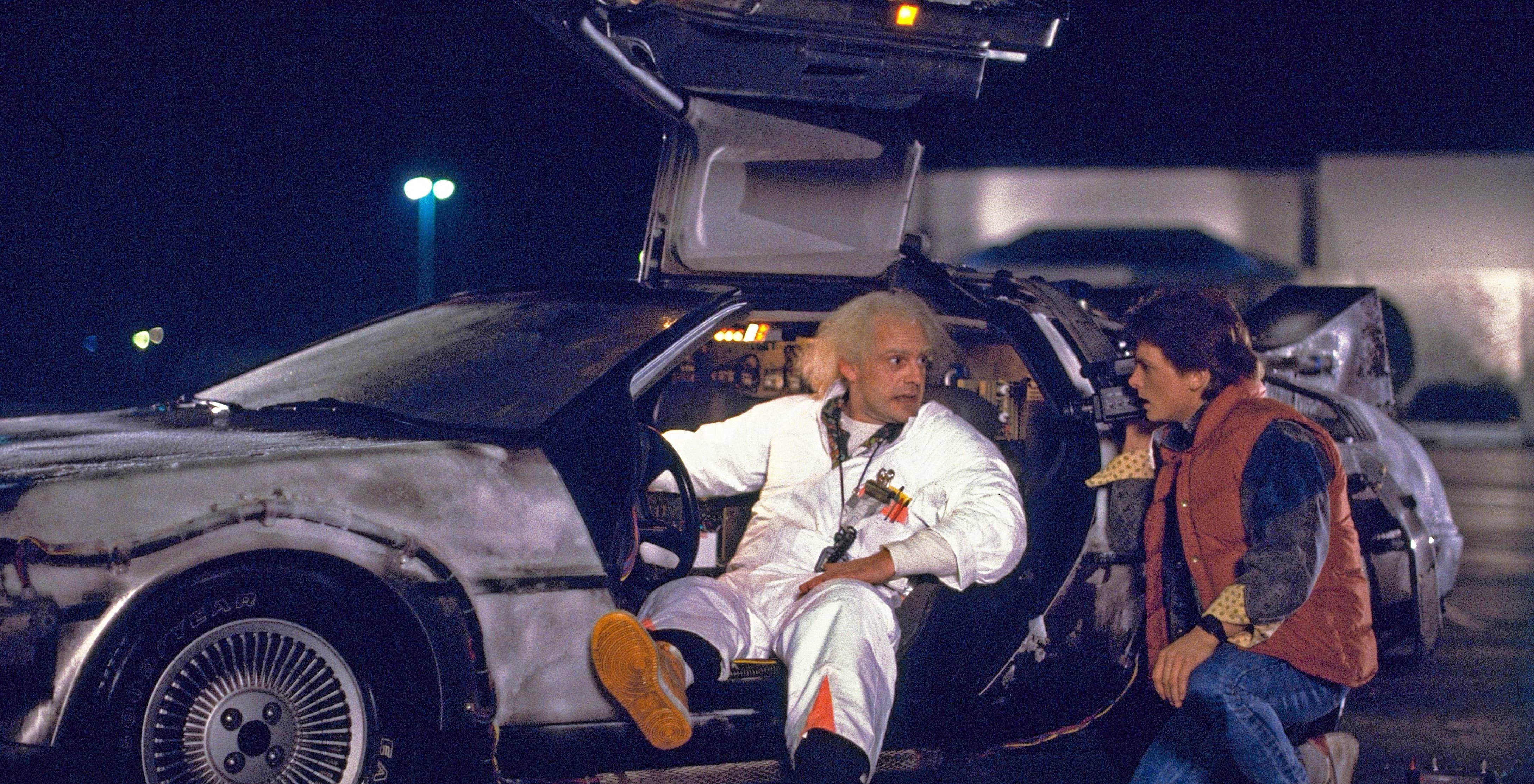
Back to the Future: Wheels on Fire
Visual effects supervisor Ken Ralston and the ILM effects team behind 1985’s biggest hit.
Years ago, a youthful Ken Ralston gained an enormous reputation as a photographer of space ships hurtling through “a galaxy far, far away” in George Lucas’ Star Wars saga. Today he is one of the five visual effects supervisors at Industrial Light and Magic who oversee a small army of technicians and artists whose collective skills make the most imaginative fiction possible on the screen.
One of Ralston’s recent films is Back to the Future, which proved to be the major box-office attraction of the past summer. The Universal release, which was directed by Robert Zemeckis from an original script by Zemeckis and producer Bob Gale, is the sort of show that could have been an absurdity had it been produced less skillfully.
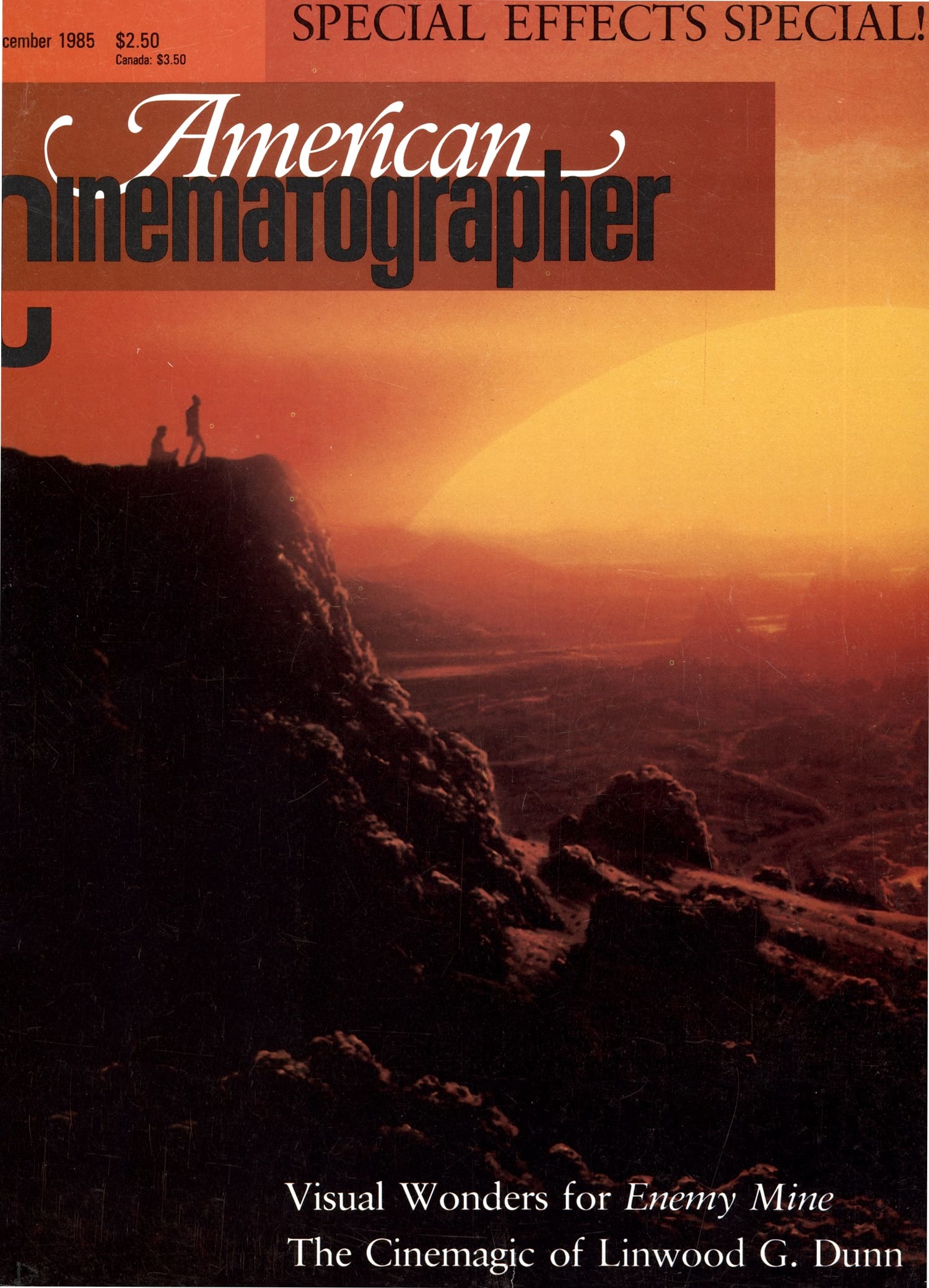
The story concerns a likable young man, Marty McFly, played by Michael J. Fox, who becomes involved in the experiments of Doc Brown, an eccentric scientist played by Christopher Lloyd. His invention, a plutonium-powered time machine designed around a DeLorean auto, takes Fox back to 1955, where he meets his parents before they were married. The future mother and father are incompatible, which means Fox must bring them together or he will have no future to return to. Complications: the mother prefers Fox to his future father and the DeLorean’s power supply is exhausted. But it all comes right at the end.
About a month after he had begun work on Cocoon, Ralston saw the script of Back to the Future and agreed to supervise it as well. “I took the project initially because there were a lot of pyrotechnics in it,” Ralston explained. “In the first draft of the script, to get back to the future Marty had to go through one of the first A-bomb testing sites and drive into an A-bomb that’s dropped on him. That really intrigued me because we were going to have to duplicate all the old footage you’ve seen where the blast rips those buildings and houses out of the ground. I thought, great! We need some work in here for the pyrotechnic guys and it’ll be perfect. I can get a crew and I can high-speed that stuff and will hardly have to think about it.
“And, as usual, as soon as I was on the show, it changed dramatically. It was better for the show: a lot more intimate and you can have a lot more fun with the character of Doc Brown up on the clock tower than getting him involved in an atomic explosion. And it was far better for the producers, because their budget wouldn’t allow what we wanted to do and they couldn’t build the sets in the desert with what they had. So they changed the whole concept and rewrote the ending and it turned out to be a much more suspenseful and fun kind of show."

“The thing that’s deceiving about Back to the Future is that the effects work blends so well with what’s happening that people aren’t even thinking ‘effects,’ no matter how outrageous they are,” Ralston pointed out. “There are actually about 30 effects shots in it. There are a lot of things going on in them, but the feeling we wanted to get and that the director, Bob Zemeckis, asked for was a really violent and incredibly bold look to everything.
“It was one of the harder shows to do. They had written it, apparently, to be shot on warm summer nights in L.A. Actually, we had to shoot it in winter, and it was raining and freezing all night. My problem was that I was doing two shows at once. There was a span of about three weeks when the worst happened: I was still in L.A. doing Back to the Future at night but I still had to be involved with Cocoon during the day. I was up for 24 hours many times, and it burned me out for a while. I almost went too far, but luckily it sort of scheduled itself out — but it came close!” He winced at the memory, but added: “It was a good education, to be on two totally different productions and see how two totally different groups handle films.
Ralston doesn’t agree with the idea someone expressed that visual effects techniques become routine with experience. “This work never gets easy,” he stated flatly. “I always try to con myself when I see a shot that seems simple, and that shot always turns out to be the worst one I have to do. No matter how much we do this work it’s always like we were doing it for the first time. There are so many variables — one little thing goes wrong and you’re screwed. Everyone here has that problem. I certainly don’t plan to do two shows at once again. But I was lucky, I guess, to end up working on the two big films of the summer. In this field you always hope the effects you’re doing will be utilized well by the people who take your work. If it works when they put the sound and music to it, great! It makes you feel really good.”
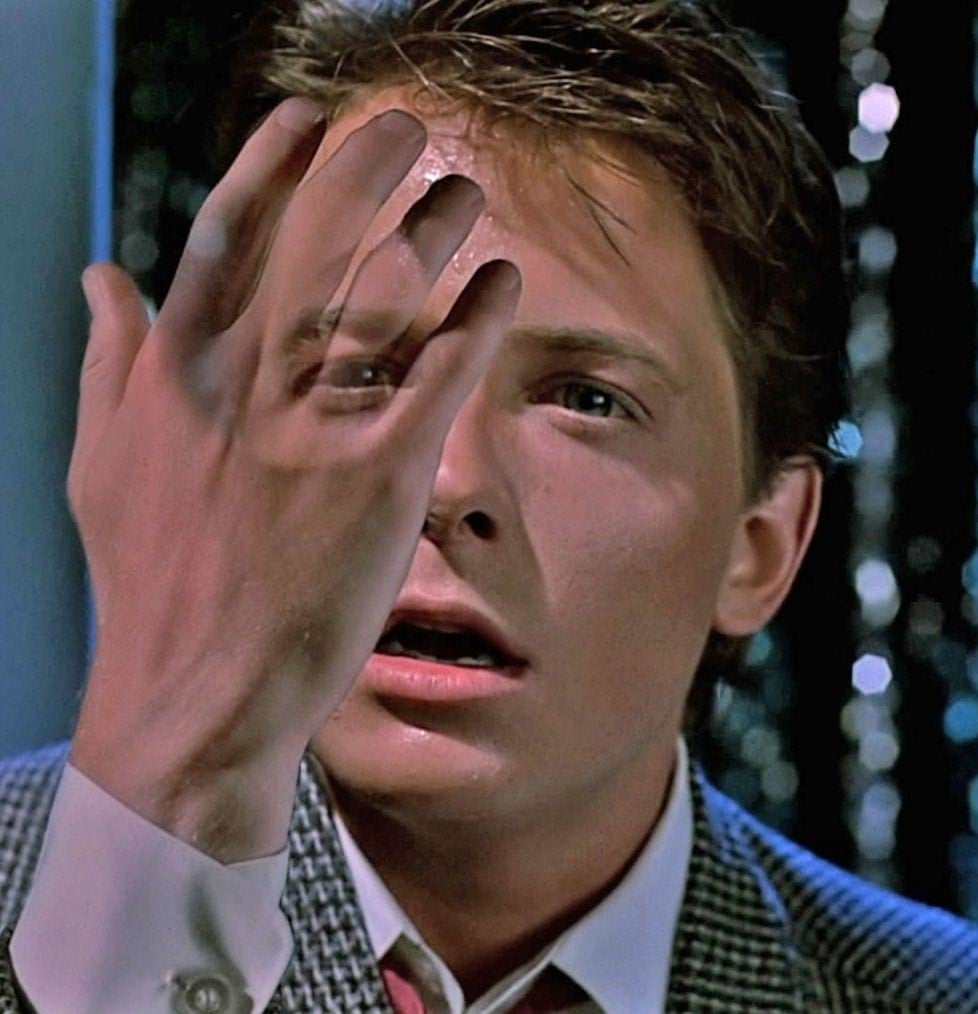
Only one scene in the picture disappointed Ralston: “It’s the shot where Marty puts his hand up to his face and a hole starts to form in his hand. That was cursed from the beginning and nothing worked out for it. Bob directed it up here. Just for protection, I shot a bluescreen of Michael just standing there and not doing anything with his hand, and then I shot a bluescreen of the hand alone — because I wasn’t sure which direction we were going to go for the effect. When we put it together, they got the black-and-white composite and they thought we had shot the hand out of scale, which wasn’t true. We just don’t do things like that! The problem was the lens they had picked, a wide-angle — his hand was monstrous. What we finally did was to make the hand about one third the size of a normal hand. Something is weird about it, but they felt that it worked better, but it never did work for me. It’s the weakest shot in the show, but it doesn’t stand out badly, and at that point in the film, the movement will carry you through — and audiences, I guess, are liking it.”
Bluescreen compositing is utilized so often at ILM that it has been expanded into some unusual areas. “There’s the shot of Doc and Marty standing on the parking lot and you see their distorted reflections on the wet pavement,” Ralston pointed out. “That doesn’t look like bluescreen, but it is. And that’s bluescreen where the fire goes between their feet and there are all sorts of roto effects going on.”
He was especially pleased with the scene in which the automobile materializes. “Doc is talking and suddenly he grabs Marty and starts to spin him out of the way of the camera. We pan off the background and them, and that’s all bluescreen — the actors were bluescreened separately from the background. We pan off as the car is forming and skids into the shot and spins around, then it’s frozen as it comes back into the present. That was certainly one of the better bluescreen things.”
“It really depends on the action of the scene, what you can get away with, and you try to get away with as much as possible.”

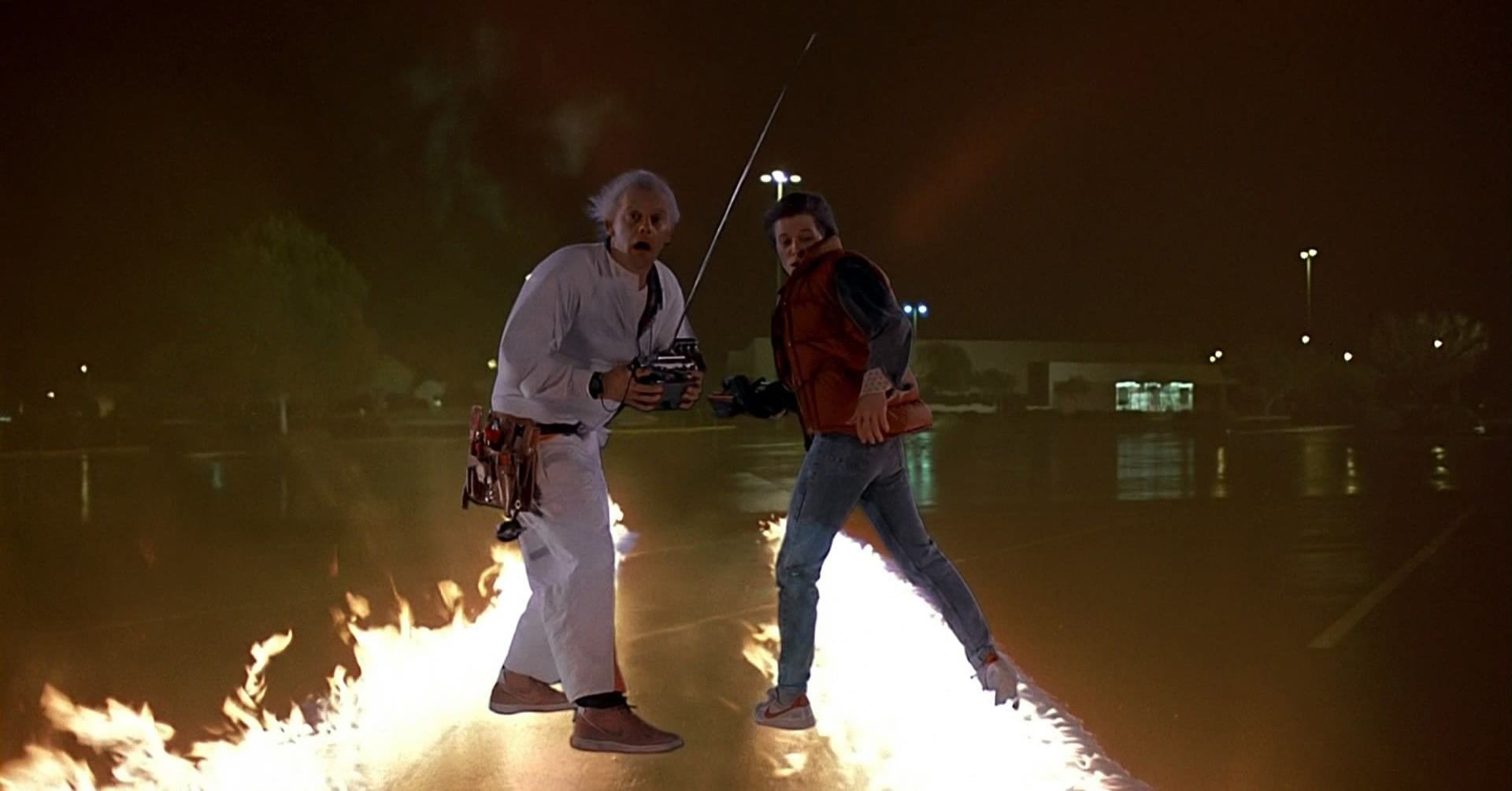
Bluescreen work at ILM is done with Eastman 5247 film even when first-unit photography utilizes 5294. “We’ve used 94 on the backgrounds, but we can’t use it on the bluescreen” Ralston said. “We’ve done some tests here on it and it just doesn’t work. There’s no real reason in most cases to use anything but 47 on bluescreen, because you’re in a controlled environment. Yet, I would like to see 94 become finer-grained because the majority of the DPs out there are using 94, which they can light easier and it makes their lives easier and makes my life miserable, because I have to go with their same lighting or insist that they beef up all their light for a particular set. All the stuff in Back to the Future and a lot of the stuff in Cocoon was 94, but because of the effects action that’s happening in those shots — and the audience is watching that — we can get away with it. We are so attuned to that stuff we pick up on every flaw; we can’t escape it. It really depends on the action of the scene, what you can get away with, and you try to get away with as much as possible.”
The most memorable effects scene is near the end of the picture, when Doc Brown’s auto/time machine flies down the street, above the pavement, but beneath the branches of the trees that line the lane, turns around several hundred yards away and speeds back toward the camera.
“That flying car was built by Steve Gawley, head of the model department, with Ira Keeler and Mike Fullmer and just about everybody else Steve had available,” Ralston noted.
“It was a fun project for us because it was something people could relate to. It’s a car. That is kind of new to us; it is our first car.”

Gawley described the miniature car: “Our miniature of the DeLorean time machine only appeared in the shot at the end of the film. It was a neat vehicle, and maybe if they make a sequel you will get to see more of it. It does exactly what the big one did — and it flies. That project involved five men and we took a few months to build the thing.
“The wheels light up to simulate rocket thrust. They actually extend from the body and fold down on cue. All the neon lights on the body are functional. The two big thrusters on the back are functional — they are projector bulbs. The tail lights are functional. It was a fun project for us because it was something people could relate to. It’s a car. That is kind of new to us; it is our first car. We actually have a gal next door in our accounting division that owned a DeLorean. While they were building the life size car in Los Angeles, we borrowed her car and got the basic shape of it from photographs. Then we started the body shape itself. We knew it had wheels and tires and it was stainless steel. We got detailed pictures of the real one later; I figured the specs for what we needed. We got some side shots and rear shots and we detailed it from the photographs.”
Gawley revealed some details of how the car was constructed: “It was built in one-fifth scale. It’s about 33 inches long and an epoxy lay-up rather than fiberglass because we wanted it stronger and thinner than you can get with fiberglass. It can be held or mounted from five axes. Actually, the ‘stainless steel’ finish is just paint that we rubbed with steel wool to give it that texture. The tires are actually not rubber, they’re aluminum. That is because we used halogen lights in each wheel to simulate rocket thrust and they generate a tremendous amount of heat, and we could leave the tire lights on for about an hour before we had to turn them off.
“Ken felt that the interior was not going to be seen, so the car had no puppets in it. We put a little coating of blue chalk on the windows to simulate the reflections of a blue sky. When the shot was first designed, it was supposed to go up and hover, almost like a helicopter take off. Then things got changed around...”
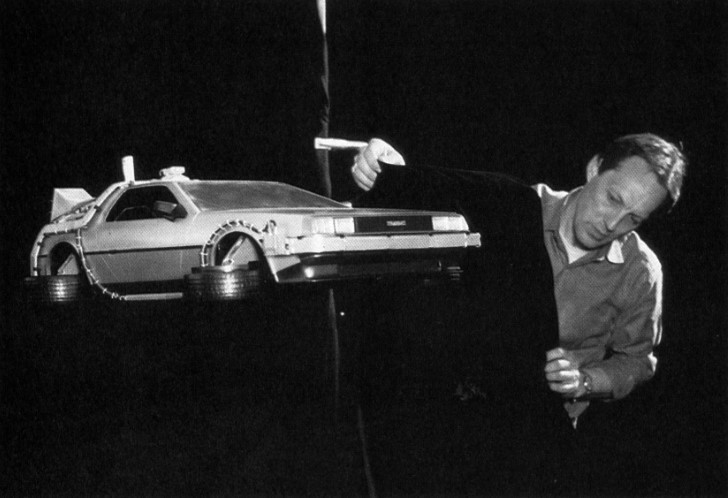
After the work of the modelmakers was done, it was up to Ralston to put the flying car on film. He told us how he did it: “I did one day of testing and I personally programmed the whole thing and shot it in one other day — it took just two days to do. We had to do it because we were way out of time on that show, and then right at the worst part of it they cut about two weeks out of our schedule because they moved up the release date. They handed out thousands of those buttons — ‘On July 19 we’re going BACK TO THE FUTURE’ — but it was really July 3! So we killed ourselves for a few days getting the thing shot.
“It’s motion controlled and fairly conventional as far as the shooting is concerned, although we had a lot of lighting things to do on it and passes with the rockets that come out for an instant. That was shot in a smoke environment, where the wheels formed the cylinders of light. And there were backup lights and the lights that came out of those — I don’t know what they are — those retro-looking square things. We had neon lights that worked on it. Everything matched the full-scale car as closely as we could do it.
“Shooting it in motion control was difficult because it did a complete turnaround and came back, and we had to mount it in such a way that it didn’t interfere with people seeing the car. I was debating on shooting in two different mounting and lighting situations, but that just complicated it too much. It would have destroyed the continuity of it, I think, to lose that turnaround, going behind the tree and flying back.
“It had to go all the way down the track with all the memory units we had; I was stretching it as much as I could. Then it comes back and almost hits the camera and goes into time at the very end.
“The plate was shot at Arleta, California, on a very windy day after a storm had just cleared in L.A. Luckily for us, the sky was so bright that we could pull mattes off the background tree that it goes behind. When it comes back, that was pulled off an actual element, but when it goes into the distance that was an articulate matte created by Barbara Brennan in the animation department. When it goes under the tree, that was our matte, and when it comes out from behind the tree that’s also our matte, but it was created a different way. We also pulled a matte off the foreground leaves, which were pretty dark against a light sky, because there are moments when the car is behind those as it comes towards you. There are a lot of animation effects just at the very end when the thing starts going back in time and — boom! — there’s a whiteout. Jack Mongovian animated shadows on the ground, which are very well done.
“At the last moment, Bob Zemeckis thought it would be funny to put a little turn signal on the car when it goes back and does the turnaround. I don’t know if anyone sees it, but it’s there — a little tiny thing blinking on and off. It was done in animation because we didn’t have that when the scene was shot.
“When the car first takes off, we show some liquid nitrogen vapor at high speed blowing off and we put that over the scene just for an instant, so that it gives the effect of a lot of debris coming off the road, and got rid of it quick when the car blasts away, to give the impression it blew it away. It was a difficult shot to program, getting it to match the perspective and what was going on in the street.”
As is usually the case when elaborate effects are being produced, time was the great enemy. “I can’t tell you how close to the wire we were on that shot,” Ralston explained. “They were standing by at the lab to grab it and print it. The one thing that isn’t in the shot, although no one notices it, is that there are no shadows on the car when it goes through all the shadows of the trees. Because, at first, you’re looking at the back of the car and there’s so much going on. But when it comes out, there are a few moments where I wanted to have some shadows. We had all the materials to do it, but we didn’t have the time. If we’d had two more days, we could have done it, but it doesn’t really matter because no one sees the difference. What Bob wanted was to keep the gag always ahead of the audience, so you see it, but by the time you get it it’s practically over.”
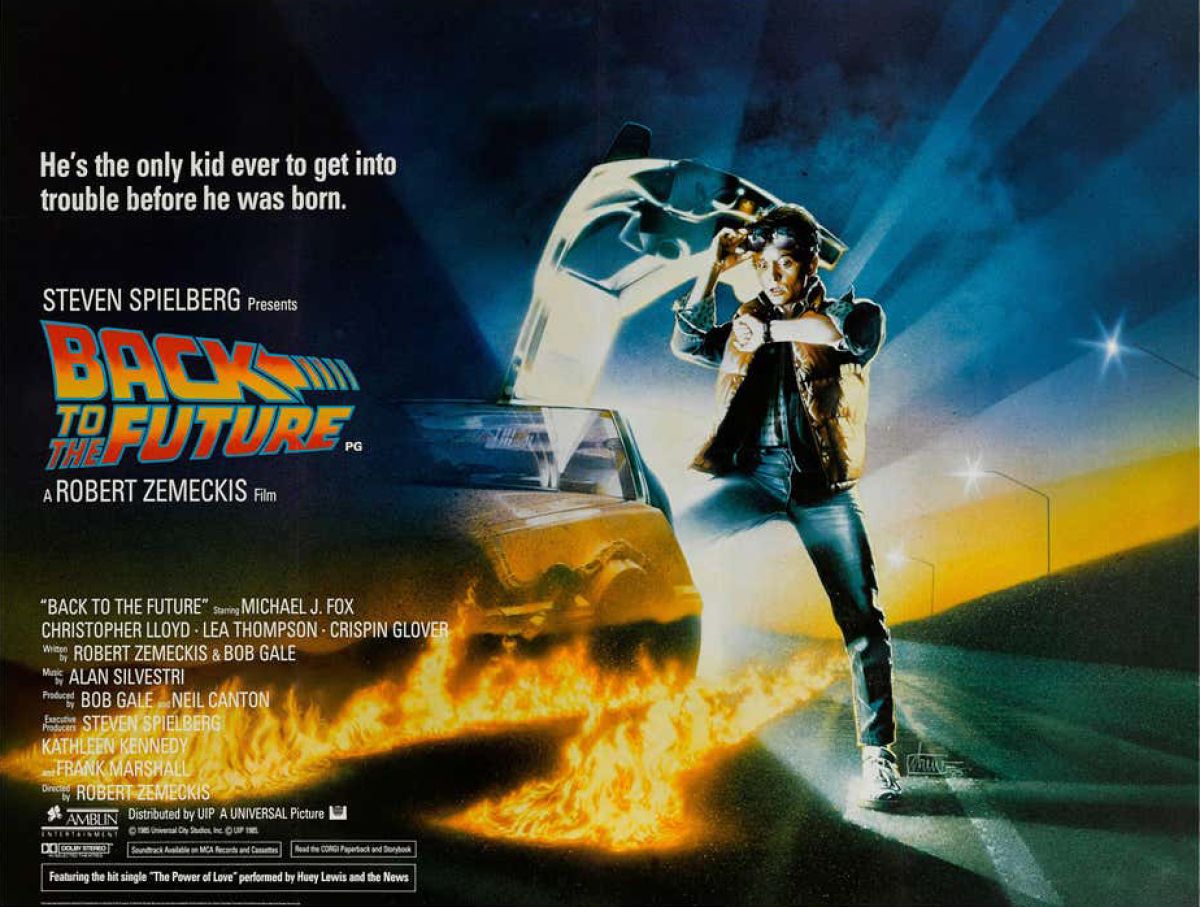
Another short but extremely difficult shot is a side view of the auto going into time. “Although it’s very quick — something over 200 frames — there was a lot of grief over that shot,” Ralston recalled. “It was murder just trying to come up with the look of it. Just the concept of the car went around and around so many times that it delayed us in getting the shot. All of our meetings seemed to center around that particular effect and we were going all directions. On a [Steven] Spielberg show, there are so many great minds at these meetings that ideas are going everywhere and it takes a while to narrow them down to something that you can do.”
Ralston described the desired scene: “A side shot with the camera trucking along with the car and then all the effects start up and it shoots the thing foward, things come out of it and it goes into a big whiteout.” It was hoped that the scene could be accomplished with pyrotechnics and physical effects on a stage. “We tried; it didn’t work,” he recalled. “We tried all kinds of different things for that.” At last, the added effects were animated into the scene. “I think the animators did a great job on it. It really looks pyrotechnic in quality; it doesn’t look animated. It looks like physical things that we could never have shot.”
Animation supervisor Bruce Walters said that “The lightning and electrical effects were standard animation, drawn in ink on paper and we let opticals add in the glows.” In this process, high-contrast mattes are made of the artwork, and the glowing effects are created through diffusion in the optical printer. “The thing we called a ‘time slice’ — where the car goes through the time warp — was the same idea, basically. It required a lot of overlapping art work because there was a lot going on — ricocheting comets and glows and action.
“One tricky thing were the shots of the snapshot in the neck of the Marty’s guitar, with him and his brother and sister in the photo gradually disappearing one at a time. Steve Gawley built a larger-than-life model of the guitar head that was about a foot long and six inches wide. We had photographs made that were about 8" x 10". In the photo are the three characters standing in front of an old well. To make them disappear we tried two techniques. In one version we had four different pictures. The first had the well only, the second had one person in it, the third had two people and the fourth had all three characters. We tried to dissolve between each one.
“Another technique was to use one picture of the well and cut the characters out from the other pictures and stick them on one at a time. Then we did dissolves to make them appear and disappear.”
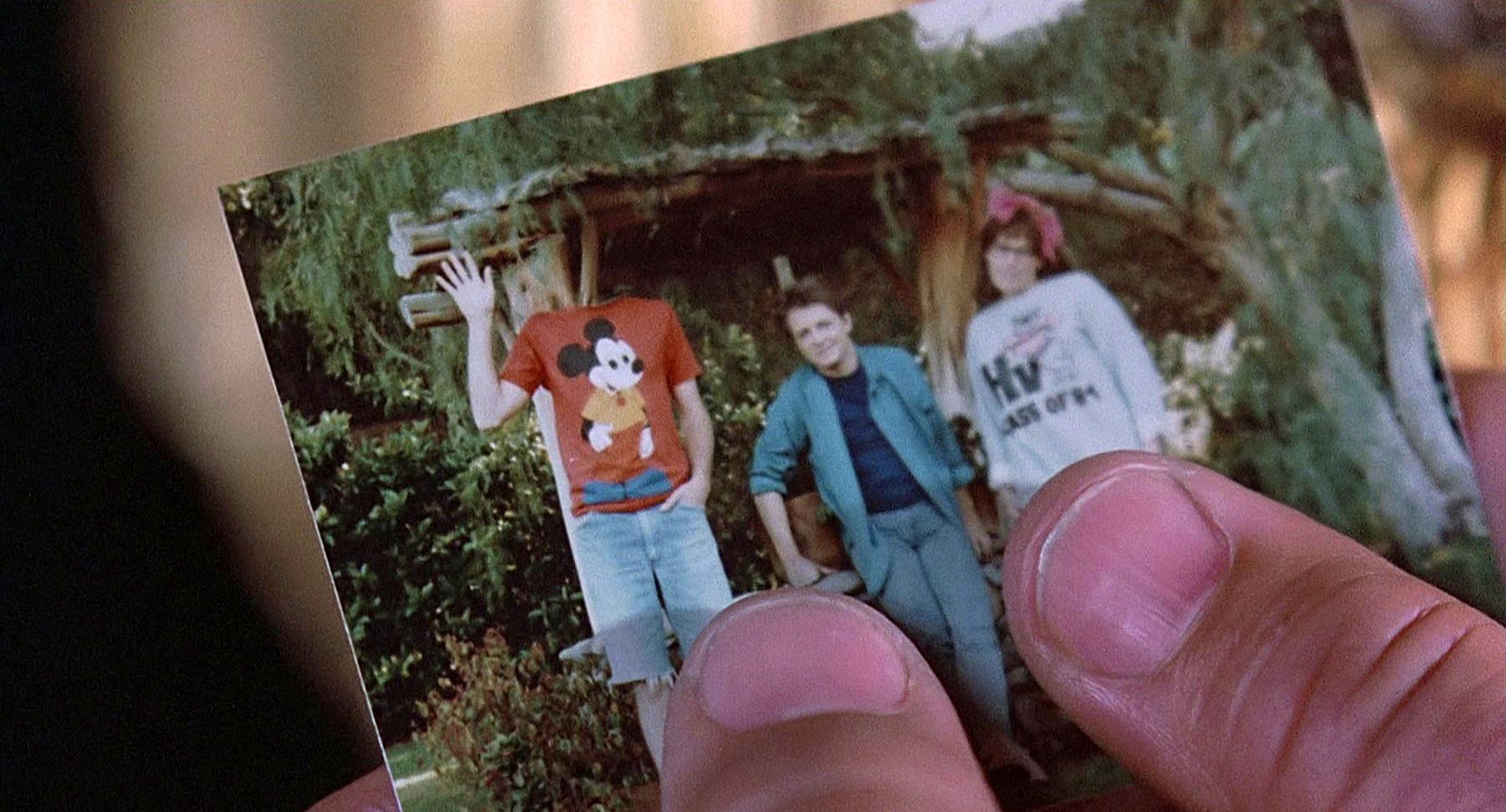
“Another technique was to use one picture of the well and cut the characters out from the other pictures and stick them on one at a time. Then we did dissolves to make them appear and disappear. The photograph was stuck on the guitar neck so it wouldn’t move and the guitar neck was moved around so it looked like somebody was playing it. Once we got the move in there, we could trick around with the picture and it would always match, even if we did dissolves on multiple passes.”
Ralston mentioned one important aspect of creating visual effects for outside clients: “We try to set things up so we’re not wasting everybody’s time, because that can happen easily. Schedules are tight because it costs so much to make films now that if you waste two minutes you have people breathing down your neck and that only makes things worse.
“It’s a fascinating, ridiculous way to make a living. It’s amazing that anyone can do it and survive. While you’re doing it it’s just killing you and you’re complaining, but you just keep going and you want to try it again and again. You know, our particular niche is the most bizarre aspect of films.”
And if you're a fan of the DeLorean itself, check out this drama on the man John DeLorean himself, Road to Ruin: Driven.






